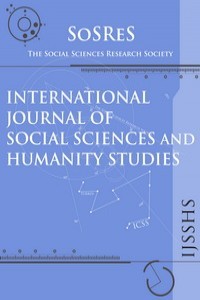RELATIONSHIP BETWEEN AFFECTIVE COMMITMENT AND ORGANIZATIONAL SILENCE: A CONCEPTUAL DISCUSSION
RELATIONSHIP BETWEEN AFFECTIVE COMMITMENT AND ORGANIZATIONAL SILENCE: A CONCEPTUAL DISCUSSION
___
- Aktan, C. C., 2006. Organizasyonlarda Yanlış Uygulamalara Karşı Bir Sivil Erdem, Ahlaki Tepki ve Vicdani Red Davranışı : Whistleblowing, Mercek Dergisi: 1-13.
- Allen, N. J., Meyer, J. P., 1996. Affective, Continuance, and Normative Commitment to the Organization: An Examination of Construct Validity, Journal of Vocational Behavior, 49: 252-276.
- Allen, N. J., Meyer, J. P., 1990. The measurement and antecedents of affective, continuance and normative commitment to the organization, Journal of Occupational Psychology, 63: 1-18.
- Bayram, L., 2005. Yönetimde Yeni Bir Paradigma: Örgütsel Bağlılık, Sayıştay Dergisi, 59: 125-139.
- Becker, H. S., 1960. Notes on the Concept of Commitment, The American Journal of Sociology, 66(1): 32-40.
- Ceylan, C., Bayram, N., 2006. Mesleki Bağlılığın Örgütsel Bağlılık ve Örgütten Ayrılma Niyeti Üzerine Etkilerinin Düzenleyici Değişkenli Çoklu Regresyon ile Analizi, İktisadi ve İdari Bilimler Dergisi, 20(1): 105-120.
- Donaghey, J., Cullinane, N., Dundon, T., Wilkinson, A., 2011. Reconceptualising Employee Silence : Problems and Prognosis, Work, Employment and Society, 25:1, 51-67.
- Dutton, J. E., Duberich, J. M., Harquail, C. V. (1994). Organizational Images and Member Identification Adminitrative Science Quarterly, 39, 239-263
- Gale Encyclopedia of Psychology, 2nd ed. Gale Group, 2001
- http://findarticles.com/p/articles/mi_g2699/is_0000/ai_2699000012/
- Gül, H., Örgütsel bağlılık yaklaşımlarının mukayesesi değerlendirilmesi, http://eab.ege.edu.tr/pdf/2_1/C2-S1-M4.pdf, 37-56.
- Jing, C., Xiao-hua, S., 2009. The Relationship Research among Organizational Commitment, Employee Satisfaction and Work Performance, International Conference on Management Science & Engineering (16th), 619-624.
- Meyer J., Becker, T., Vandenberghe, C. (2004). Employee Commitment and Motivation: A conceptual analysis and Integrative Model. Journal of Applied Pschology, 89(6), 991-1007.
- Morrison, E. W., Milliken, F. J., 2000. Organizational Silence: A Barrier to Change and Development in a Pluralistic World, The Academy of Management Review, 25(4): 706-725.
- Morrison, E. W., Milliken, F. J., Hewlin, P. F., 2003. An Explatory Study of Employee Silence: Issues That Employees Don’t Communicate Upward and Why, http://w4.stern.nyu.edu/emplibrary/Milliken.Frances.pdf, 1-35.
- Özdevecioğlu, M., 2003. Algılanan Örgütsel Destek İle Örgütsel Bağlılık Arasındaki İlişkilerin Belirlenmesine Yönelik Bir Araştırma, D.E.Ü. İ.İ.B.F. Dergisi, 18(2): 113-130.
- Rhoades, L., Eisenberger R., Armeli, S., 2001. Affective commitment to the organization: The contribution of perceived organizational support, Journal of Applied Psychology, 86(5): 825-836.
- Tutar, H., Altınöz, M., 2010. Örgütsel İklimin İşgören Performansı Üzerine Etkisi: Ostim İmalat İşletmeleri Çalışanları Üzerine Bir Araştırma, Ankara Üniversitesi Siyasal Bilgiler Fakültesi Dergisi, 65(2): 196-218.
- Tutar, H., 2007. Örgütsel Eylemsizliği Açıklama Aracı Olarak Öğrenilmiş Çaresizlik, “İş,Güç” Endüstri İlişkileri ve İnsan Kaynakları Dergisi, 9(4): 142- 161.
- Uyguç, N., Çımrın, D., 2004. DEÜ. Araştırma ve Uygulama Hastanesi Merkez Labaratuvarı Çalışanlarının Örgüte Bağlılıklarını ve İşten Ayrılma Niyetlerini Etkileyen Faktörler, D.E.Ü. İ.İ.B.F.Dergisi, 19(1): 91-99.
- Wei, G., Tai, L., 2010. An Empirical Study on Organizational Commitment and Turnover of IT Industry, International Conference on E-Business and E- Government, 904-906.
- Yüceler, A., 2009. Örgütsel Bağlılık ve Örgüt İklimi İlişkisi: Teorik ve Uygulamalı Bir Çalışma, Selçuk Üniversitesi Sosyal Bilimler Enstitüsü Dergisi, 22: 445-458.
- Başlangıç: 2009
- Yayıncı: Sosyal Bilimler Araştırmaları Derneği
DIFFERENT TYPES OF CAPITALS MOBILIZED TO STRENGTHEN LOCAL POLITICAL LEADERSHIP
WE ARE NOT OURSELVES - FEMALE CHARACTERS IN BHARATI MUKHERJEE’S NOVELS
TRANSATLANTIC FREE TRADE AGREEMENT - STILL ALIVE OR DEAD CONCEPT IN EU-US RELATIONS?
Nuriye GÜREŞ, Seda ARSLAN, Harun YILMAZ
VALUE ORIENTATIONS AND MOTIVATIONAL STRUCTURES IN DANCE STUDENTS
TACKLED - THE IMMERSION OF SOCIAL WORK PROFESSION INTO THE REALM OF HIGH COLLISION SPORTS
